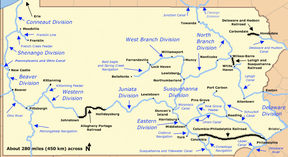Conewago Canal facts for kids
Quick facts for kids Conewago Canal |
|
|---|---|

Map of historic Pennsylvania canals and connecting railroads
|
|
| Specifications | |
| Locks | 3 |
| Maximum height above sea level | 384 ft (117 m) (Elevation of York Haven) |
| Status | Abandoned |
| History | |
| Original owner | Francis Thomas |
| Principal engineer | James Brindley, nephew of the James Brindley who built the Duke of Bridgewater's canals in England |
| Construction began | 1793 |
| Date completed | 1797 |
| Geography | |
| Start point | York Haven |
| End point | York Haven |
The Conewago Canal was a short waterway built on the west bank of the Susquehanna River in Pennsylvania. It was located near York Haven, Pennsylvania, about 11 miles (18 km) south of Harrisburg. This canal helped boats safely get around the dangerous Conewago Falls rapids.
Building the canal started in 1793 and finished in 1797. It was less than 1 mile (1.6 km) long. Robert Morris, a businessman from Philadelphia, organized the project. The main engineer was James Brindley, whose uncle was a famous canal builder in England.
The canal had three locks. Two were "lift locks" that helped boats move up or down 19 feet (5.8 m) in elevation. A "guard lock" kept too much water from entering, especially during floods. Using the canal, a boat could travel upstream in just 37 minutes. Without it, it would take 30 or 40 men a whole day to pull a boat upriver.
Even with the canal, shipping on the river was limited to only a few months each year. This was because the river's water levels changed a lot. Also, boat captains didn't like paying the fee to use the private canal. Instead, some used "river arks," which were special boats that could handle the rapids without much damage. This way, they avoided the toll. Later, the Eastern Division of the Pennsylvania Canal was built. It bypassed this same part of the river.
Why Was the Conewago Canal Built?
The Susquehanna River above Conewago Falls was easier to travel on. Boats like "keelboats" and "Durham boats" could carry goods there. But the last 50 miles (80 km) of the river, leading to the Chesapeake Bay, were fast, shallow, and full of rocks.
Shipping Before the Canal
Before the Conewago Canal was built, most boats stopped at Middletown. They would unload goods like lumber, wheat, and iron. These goods then had to be shipped over 100 miles (160 km) of bad roads to Philadelphia.
Middletown and York Haven became important places for making flour. It was cheaper to ship barrels of flour by wagon than to ship unmilled wheat. In 1791, the government of Pennsylvania decided to spend money to make the Susquehanna River better for travel. This was part of a plan to improve trade with Philadelphia. The Conewago Canal, even though it was built with private money, fit into these bigger plans.
Connecting to Other Trade Routes
Pennsylvania also wanted to improve roads for trade between the east and west. The Philadelphia and Lancaster Turnpike was a major project. It was a 64-mile (103 km) stone and gravel road built by a private company in 1794. In 1803, another 10 miles (16 km) were added, connecting Lancaster to Columbia and the Susquehanna River.
After 1797, boats could use the Conewago Canal to get past the rough water. They could then continue to Columbia, where their goods were unloaded and put onto wagons. After 1803, the improved road went all the way from Columbia to Philadelphia. This made it much easier to move goods across Pennsylvania.

